View in other NatureServe Network Field Guides
NatureServe
Montana
Utah
Wyoming
Idaho
Wisconsin
British Columbia
South Carolina
Yukon
California
New York
Adder's Tongue - Ophioglossum pusillum
Other Names:
Ophioglossum vulgatum [misapplied name]
State Rank Reason (see State Rank above)
Rare in Montana, where it is known from a couple dozen fens and wet meadows in the northwest corner of the state. Its viability in the state generally does not appear to be at risk from any human-caused impacts at this time.
- Details on Status Ranking and Review
Population Size
Score2 - Small: Generally 2,000-10,000 individuals.
Range Extent
Score1 - Peripheral, Disjunct or Sporadic Distribution in MT: Widespread species that is peripheral, disjunct or sporadically distributed within MT such that it occurs in <5% of the state (<7,500 sq. miles or the combined area of Beaverhead and Ravalli Counties) or is restricted to 4-5 sub-basins.
Area of Occupancy
Score1 - Moderate: Generally occurring in 11-25 Subwatersheds (6th Code HUC’s).
Environmental Specificity
Score1-2 - Moderate to High.
Trends
Score0-1 - Stable to Minor Declines:
CommentTrend data are unavailable. Habitat generally appears to be stable and it does not appear likely that severe declines have occurred, though it is possible that minor declines have occurred or may be occuring across the species' range in Montana due to drought conditions or other factors.
Threats
Score0-1 - Low to Medium.
Intrinsic Vulnerability
Score1-2 - Moderate to High Vulnerability.
Raw Conservation Status Score
Score
6 to 10 total points scored out of a possible 19.
General Description
Adder's Tongue is an herbaceous perennial that is up to 20 cm high. Each plant has an erect, leafless stem that is 2-15 cm high and which branches into a single leaf-like, ascending, sterile blade and into an erect, spike-like fertile stalk. The sterile blade is elliptic to broadly lance-shaped and 2-8 cm long with entire margins and a rounded to pointed tip. The upper portion of the fertile stalk has 2 rows of contiguous spore-bearing sacs on one side.
Phenology
Producing spores in June - early July; sporophores persisting.
Diagnostic Characteristics
There is no other fern ally with a single entire-margined blade.
Species Range
Montana Range
Range Descriptions
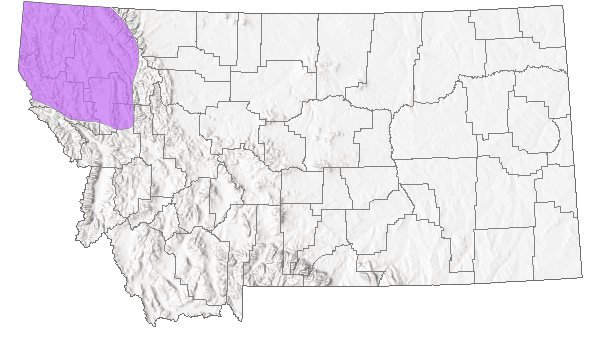
 Native
Native
Range Comments
In MT restricted to Lincoln, Flathead, Lake and Missoula counties; BC to NL south to CA, MT, IA, and MD (Lesica et al. 2012. Manual of Montana Vascular Plants. BRIT Press. Fort Worth, TX).
Observations in Montana Natural Heritage Program Database
Number of Observations: 53
(Click on the following maps and charts to see full sized version)
Map Help and Descriptions
Relative Density
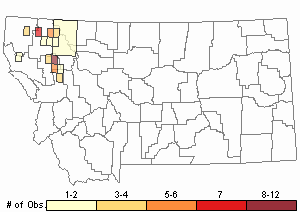
Recency
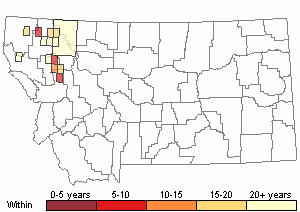

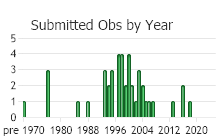
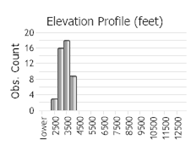 (Observations spanning multiple months or years are excluded from time charts)
(Observations spanning multiple months or years are excluded from time charts)
Habitat
Wet meadows, margins of fens, and gravelly moist soil in the valley and montane zones.
National Vegetation Classification System Groups Associated with this Species
Wetland and Riparian
Alpine Riparian and Wetland
Peatland
Riparian and Wetland Forest
Riparian Shrubland
Wet Meadow and Marsh
Stewardship Responsibility
References
- Literature Cited AboveLegend:
 View Online Publication
View Online Publication Lesica, P., M.T. Lavin, and P.F. Stickney. 2012. Manual of Montana Vascular Plants. Fort Worth, TX: BRIT Press. viii + 771 p.
Lesica, P., M.T. Lavin, and P.F. Stickney. 2012. Manual of Montana Vascular Plants. Fort Worth, TX: BRIT Press. viii + 771 p.
- Additional ReferencesLegend:
 View Online Publication
View Online Publication
Do you know of a citation we're missing? Douglas, G. W., G. B. Straley, and D. Meidinger (eds.). 1989. The vascular plants of British Columbia. Part 1 - Gymnosperms and Dicotyledons (Aceraceae through Cucurbitaceae). Ministry of Forests, Victoria, BC. 208 pp.
Douglas, G. W., G. B. Straley, and D. Meidinger (eds.). 1989. The vascular plants of British Columbia. Part 1 - Gymnosperms and Dicotyledons (Aceraceae through Cucurbitaceae). Ministry of Forests, Victoria, BC. 208 pp. Lellinger, D.B. 1985. A Field Manual of the Ferns and Fern-Allies of the United States and Canada. Smithsonian Inst. Press. Washington, D.C. B85LEL01PAUS
Lellinger, D.B. 1985. A Field Manual of the Ferns and Fern-Allies of the United States and Canada. Smithsonian Inst. Press. Washington, D.C. B85LEL01PAUS Lesica, P., M.T. Lavin, and P.F. Stickney. 2022. Manual of Montana Vascular Plants, Second Edition. Fort Worth, TX: BRIT Press. viii + 779 p.
Lesica, P., M.T. Lavin, and P.F. Stickney. 2022. Manual of Montana Vascular Plants, Second Edition. Fort Worth, TX: BRIT Press. viii + 779 p. Weakley, A.S. 1997. Flora of the Carolinas and Virginia: working draft of 21 July 1997. The Nature Conservancy, Southeast Regional Office, Southern Conservation Science Dept., Chapel Hill, North Carolina.
Weakley, A.S. 1997. Flora of the Carolinas and Virginia: working draft of 21 July 1997. The Nature Conservancy, Southeast Regional Office, Southern Conservation Science Dept., Chapel Hill, North Carolina.
- Web Search Engines for Articles on "Adder's Tongue"





